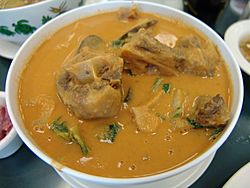Kare-kare facts for kids

A bowl of kare-kare
|
|
| Course | Main course |
|---|---|
| Place of origin | Philippines |
| Serving temperature | Hot |
| Main ingredients | Oxtail, peanut sauce, vegetables |
| Variations | Goat meat kare-kare |
Kare-kare is a popular Filipino stew known for its rich, thick, and savory peanut sauce. The word kare comes from "curry". This yummy dish is usually made with oxtail or beef tripe that has been stewed until very tender. Sometimes, pork parts like hocks or trotters are also used.
To make it even better, different vegetables are added. These can include eggplant, Chinese cabbage, daikon, green beans, and okra. The sauce gets its amazing flavor from ground roasted peanuts (or peanut butter), onions, and garlic. A special ingredient called annatto gives it a nice orange color, and ground rice helps make the sauce thick. You can also find variations of kare-kare made with seafood like prawns, squid, or mussels, or even just vegetables.
Kare-kare is often eaten with bagoong (shrimp paste), which can be plain or spiced with chili. Sometimes, a squeeze of calamansi juice is added for extra taste. It's a very important dish in Filipino culture and is often served at special events and parties.
Today, people sometimes use different meats for kare-kare. For example, leftover lechon (roasted pig) or crispy pata (crispy pork shank) can be used. Other choices include tofu, beef chuck, or even parts of a cow's face like cartilage.
Contents
History of Kare-kare
The story of kare-kare in the Philippines goes back hundreds of years. There are a few ideas about where this delicious dish came from:
From Pampanga
One idea is that kare-kare started in Pampanga, a province known as the "culinary capital of the Philippines." The people from Pampanga, called Kapampangan people, are famous for their love of cooking and for creating rich, flavorful dishes.
From Mexico
Another idea suggests that the dish, especially its peanut sauce, came from the galleon ships that sailed between the Philippines and Acapulco, Mexico. Peanuts, a key ingredient, were brought from Mexico, just like corn. In Mexico, there's a similar dish called Lomo Encacahuatado, which also uses a peanut sauce. The main difference is the type of pork used. The name "Kare-Kare" might even come from "Cari," a term used by Spaniards and Portuguese to describe the "golden brown" native people they met.
From the Moro People
Some believe kare-kare was a special dish of the Moro people who lived in Manila before the Spanish arrived. In areas like Sulu and Tawi-Tawi, kare-kare is still a very popular dish today.
From Indian Soldiers
A fourth story says that Indian soldiers, called sepoys, who settled in the Philippines during the British occupation of Manila, created kare-kare. They missed their home cooking and used local ingredients to make a dish similar to their own kari-kaari (curry). The name kare-kare is thought to come from the Tamil word kaṟi, which means "curry" or "thick sauce." Because of the peanuts in the sauce, kare-kare tastes a bit like satay.
How Kare-kare is Made
Making kare-kare involves a few steps to get that perfect rich flavor and texture.
First, the Oxtail is cut into pieces, and ox tripe is boiled until it's very soft. Sometimes, pieces of ox feet or shins are added too. As the meat cooks, the soup becomes thick and gelatin-like.
Next, ground roasted peanuts (or peanut butter) and ground roasted glutinous rice are added to the soup. These ingredients help make the sauce even thicker and give it its signature creamy texture. Annatto is then added to give the dish its well-known orange color.
Finally, different vegetables are included. Common choices are young banana flower buds (called puso ng saging), eggplant, string beans, and Chinese cabbage (pechay).
Kare-kare is usually served hot with a special bagoong alamang (sautéed salted shrimp paste) on the side. This salty and savory paste adds a wonderful contrast to the rich peanut sauce.
See also
 In Spanish: Kare-kare para niños
In Spanish: Kare-kare para niños


